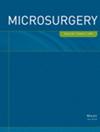Outcomes of Microsurgical Reconstruction of Post-Burn Joint Contracture—Systematic Review and Meta-Analysis
Abstract
Background
Contracture recurrence is a common setback to burn reconstruction, especially for severe or large-area contractures. Flap-based burn reconstruction has been shown to result in lower recurrent contracture rates. This study aims to summarize and evaluate the outcomes of flap-based techniques used for post-burn joint contracture reconstruction.
Methods
A systematic review was performed following PRISMA guidelines. Databases searched included PUBMED, EMBASE, Scopus, and Web of Science. Articles that described the use of flaps with a known blood supply to reconstruct post-burn contractures of the joints were included. Studies with incomplete data, with multiple anatomic site contracture involvement, case reports, and non-English articles were excluded. Data on patient demographics, flap type, complications, and contracture resolution were extracted. A proportional meta-analysis was conducted using the DerSimonian and Laird random-effects model.
Results
Out of 850 studies screened, 27 met inclusion criteria. Reconstruction of 830 joint contractures was reported. Contractures resolved for 98.9% (I2 = 0% [95% CI: 97.7–99.6]) of pedicled and 90.1% (I2 = 82.8% [95% CI: 62.7–100]) of free flap reconstructions, recurring in 1.8% (I2 = 0% [95% CI: 0.7–3.3]) at sites reconstructed with pedicled flaps and 0.6% (I2 = 0% [95% CI: 0.1–1.7]) at sites reconstructed with free flaps. The rates of flap complications were low, with total flap loss reported at 1.5% (I2 = 0% [95% CI: 0.6–2.7]) and 2.9% (I2 = 37.9% [95% CI: 0.9–5.8]) of the time for pedicled and free flaps, respectively. Partial flap loss was 6.9% (I2 = 65.1% [95% CI: 3.4–11.5]) and 5.2% (I2 = 65% [95% CI: 1.7–10.4]) for pedicled and free flaps, respectively. No significant difference was identified in rates of contracture resolution (p = 0.50), contracture recurrence (p = 0.15), total flap loss (p = 0.18) or partial flap loss (p = 0.31) regardless of the flap type used.
Conclusions
Burn contracture reconstruction using flap-based techniques shows minimal complications and low rates of contracture recurrence when used for joints. Pedicled and free flap reconstruction of burn contracture sites yield similar outcomes.


 求助内容:
求助内容: 应助结果提醒方式:
应助结果提醒方式:


